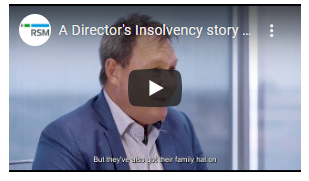Top 3 Docs Quick Launch
Create New Company Create New Family Trust Create New SMSFNew Release
Trust Distribution Minutes Library for 2024/25 - Multi-Use View Full RangeJoin
it's free
Need legal advice or a specially customised legal document?
Contact our partner law practice

Click here to arrange a quote
| Print Version | Back |
Signs of Insolvency - Part Two: Is my business ok?
Issue: 581 - Monday, 25 July 2022
In this Issue
- Signs of Insolvency - Part Two: Is my business ok?
1. Signs of Insolvency - Part Two: Is my business ok?
By Reginald Kuek, Principal, RSM Perth
It’s normal for a business to experience financial ups and downs, and even longer periods of financial stress.
But how do you tell the difference between temporary stress and financial distress leading to insolvency?
The simple definition of insolvency is when a business cannot pay its debts when they fall due. Sometimes this is a little difficult to determine – especially when cashflow is volatile and debt exists. But how do you tell the difference between temporary stress and financial distress leading to insolvency?
To get a clearer understanding of what determines whether a business is insolvent, a court case back in 2003 ascertained the following factors as evidence of insolvency:
- The business has continuing losses.
- Commonwealth and state taxes are overdue.
- Liquidity ratios (liquid assets vs short term liabilities) are below 1:1.
- There is a poor relationship with the company’s bank and an inability to borrow more money.
- The business has no access to alternative finance.
- There is no way to raise further equity capital.
- Suppliers have placed the company on “cash on delivery” terms or are demanding special payments before resuming supply.
- Creditors remain unpaid outside trading terms.
- Post-dated cheques or dishonoured cheques have been issued.
- Special arrangements exist with selected creditors.
- Solicitors’ letters, summons, judgments or warrants have been issued against the company.
- The business has made payments to creditors of rounded sums which are not reconcilable to specific invoices.
- The business is unable to produce timely and accurate financial information on its trading performance and financial position, or make reliable forecasts.
DO THESE INSOLVENCY INDICATORS STILL APPLY TO TODAY’S BUSINESSES?
It has been almost 20 years since that judgment was handed down, and the way businesses operate and manage their finances has changed dramatically.
For example:
- Most payments and receipts are paid and received electronically.
- Cash and cheque payments are rare.
- Bookkeeping is often computerised and real time information is now readily available.
- An increasing number of assets are secured by creditors.
- Most businesses have direct online access to the ATO’s portal to view statements.
- Superannuation statements can be viewed online.
- “Buy now, pay later” companies and debt factoring (selling your accounts receivables to a third party) now exist.
- E-commerce is superseding physical stores and warehousing.
While some of the classic indicators of insolvency are still relevant, we at RSM have compiled a short modern-day checklist of possible insolvency indicators.
Download a copy of the Checklist here.
RSM’s Restructuring and Recovery experts welcome the
opportunity to sit down with business owners and their advisers to
discuss their circumstances, and advise on the various options
available – including options where owners can maintain control
while a restructuring plan is worked through. Further information and
support can be obtained through RSM here.
Please also see a bonus video, The Sun will come out tomorrow, featuring past RSM Australia client Stephen Pollard, a CEO and Board Member and Greg Dudley, National Head of Restructuring and Recovery at RSM Australia talking about their restructuring experience.
Disclaimer: The content of this Bulletin is general information only. It is not legal advice. The statements and opinions are the expression of the author, not Law Central, and have not been checked for their accuracy, completeness or changes in the law. Law Central recommends you seek professional advice before taking any action based on the content of this Bulletin.
Related documents:
- Company (ELodgement)
- Loan Agreement (No Security)
- Director’s Indemnity - Compulsory Insurance
- Director’s Indemnity - No Insurance
Related webinars:
- Webinar On Demand - Three Pillars of an Effective Asset Protection Strategy
- Webinar On Demand - How to assist clients with their debt issues


 Australia
Australia  New Zealand
New Zealand
